Modernism
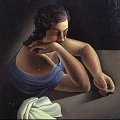 1900 - 1980. The notion of
1900 - 1980. The notion of  Modernism is closely related to 'modern art'. Modernism refers to
the new approach to art where it was no longer important to represent
a subject realistically. Instead, artists started experimenting with
new ways of seeing, with fresh ideas about the nature, materials and
functions of art, often moving further toward abstraction. Modernism
was the movement that revolutionised the world around us and the way
we live it. Amongst famous artists of modern art are Henri Matisse, Pablo Picasso, Salvador Dali, Marc Chagall, and more.
Modernism is closely related to 'modern art'. Modernism refers to
the new approach to art where it was no longer important to represent
a subject realistically. Instead, artists started experimenting with
new ways of seeing, with fresh ideas about the nature, materials and
functions of art, often moving further toward abstraction. Modernism
was the movement that revolutionised the world around us and the way
we live it. Amongst famous artists of modern art are Henri Matisse, Pablo Picasso, Salvador Dali, Marc Chagall, and more.
Modernism brought us a diversity of styles and movements:
- Symbolism (Gustave Moreau, Edvard Munch)
- Art Nouveau (Alphonse Mucha, Gustav Klimt)
- Fauvism (Andre Derain, Henri Matisse, Maurice de Vlaminck)
- Expressionism (James Ensor, Edvard Munch, Emil Nolde, Carl Eugen Keel)
- Cubism (Georges Braque, Juan Gris, Fernand Leger, Pablo Picasso)
- Futurism (Giacomo Balla, Umberto Boccioni, Carlo Carra)
- Abstractionism (Naum Gabo, Wassily Kandinsky, El Lissitzky, Kazimir Malevich)
- Suprematism (Kazimir Malevich)
- Dada (Jean Arp, Marcel Duchamp, Max Ernst, Francis Picabia, Kurt Schwitters)
- Surrealism (Jean Arp, Salvador Dali, Max Ernst, Rene Magritte, Joan Miro)
- Constructivism (Naum Gabo, Laszlo Moholy-Nagy)
- Abstract Expressionism (Willem de Kooning, Jackson Pollock, Mark Rothko)
- New Realism (Christo, Yves Klein, Pierre Restany)
- Minimalism (Alexander Calder, Donald Judd, Sol LeWitt, Richard Serra)
- Pop Art (Richard Hamilton, David Hockney, Robert Rauschenberg, Andy Warhol)
A few important artists of modern age have had no any particular affiliation with any of the major modern art movements, or their art can be attributed to have been expressed in several styles:
- Marc Chagall (Cubism, Fauvism, Surrealism)
- Giorgio de Chirico (Pre-Surrealism)
- Paul Klee (Expressionism, Cubism, Surrealism)
- Amedeo Modigliani
Artists and Articles
Edvard Munch
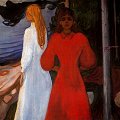 Edvard Munch is a Norwegian
Symbolist/Expressionism painter, whose intense, evocative treatment of
psychological and emotional themes was a major influence on the
development of Expressionism in the early 20th century. Munch is
acclaimed to be the greatest artist of Norway and a father of
Expressionism. Munch's art is now considered a significant force in
modern art. His art is simple, direct, and vigorous in style, yet
powerful in essence and in subject matter. Munch's art works penetrate
beyond external appearances to the inner conditions of the subjects he
painted. Munch's subject matter is symbolist in content, depicting a
state of mind rather than an external reality. The purpose of
Expressionism and Symbolism is to show emotions that the artist feels
in hopes that the viewer will be stirred and feel them as well. The
artist is not concerned with reality as it appears but with its inner
nature and with the emotions aroused by the subject. To achieve these
ends, the subject is frequently exaggerated, distorted, or otherwise
altered in order to stress the emotional experience in its most
intense and concentrated form. Interested in portraying not a random
slice of reality, but situations with emotional content and expressive
energy, Munch carefully calculated his compositions to create a tense
atmosphere.
Edvard Munch is a Norwegian
Symbolist/Expressionism painter, whose intense, evocative treatment of
psychological and emotional themes was a major influence on the
development of Expressionism in the early 20th century. Munch is
acclaimed to be the greatest artist of Norway and a father of
Expressionism. Munch's art is now considered a significant force in
modern art. His art is simple, direct, and vigorous in style, yet
powerful in essence and in subject matter. Munch's art works penetrate
beyond external appearances to the inner conditions of the subjects he
painted. Munch's subject matter is symbolist in content, depicting a
state of mind rather than an external reality. The purpose of
Expressionism and Symbolism is to show emotions that the artist feels
in hopes that the viewer will be stirred and feel them as well. The
artist is not concerned with reality as it appears but with its inner
nature and with the emotions aroused by the subject. To achieve these
ends, the subject is frequently exaggerated, distorted, or otherwise
altered in order to stress the emotional experience in its most
intense and concentrated form. Interested in portraying not a random
slice of reality, but situations with emotional content and expressive
energy, Munch carefully calculated his compositions to create a tense
atmosphere.
 Moon (1898)
© Edvard Munch
Moon (1898)
© Edvard Munch
 Winter Night (1900)
© Edvard Munch
Winter Night (1900)
© Edvard Munch
- Edvard Munch Art, $19
 (75 pictures)
(75 pictures)
- Edvard Munch. Art, life, and world of symbolic expression.
- Edvard Munch. Art, paintings, and works.
- Edvard Munch. The Scream.
Kazimir Malevich
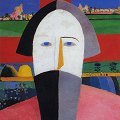 Kazimir Malevich, a Russian painter, pioneer of
geometric abstract art and the originator of the
Suprematism movement. Malevich developed his own
abstract style based strictly on geometric elements, squares and
rectangles. This style became known as Suprematism, referring to
supremacy of "pure artistic feeling". In his first paintings he
presented geometric forms in a limited range of colors, sometimes in
black alone, against a white background. Later he introduced a broader
range of colors as well as triangles, circles, and curved shapes. From
the simplest geometric shapes, Malevich built an entire Suprematist
universe. Kazimir Malevich's art and his Suprematist manifesto are
amongst the most vital artistic developments of the 20th century. He
claimed to have reached the summit of abstract art by denying
objective representation. Infinity, eternity, God, zero of form, the
void, blissful sense of liberating non-objectivity, pure art,
supremacy of pure feeling, spirit of sensation which pervades
everything...
Kazimir Malevich, a Russian painter, pioneer of
geometric abstract art and the originator of the
Suprematism movement. Malevich developed his own
abstract style based strictly on geometric elements, squares and
rectangles. This style became known as Suprematism, referring to
supremacy of "pure artistic feeling". In his first paintings he
presented geometric forms in a limited range of colors, sometimes in
black alone, against a white background. Later he introduced a broader
range of colors as well as triangles, circles, and curved shapes. From
the simplest geometric shapes, Malevich built an entire Suprematist
universe. Kazimir Malevich's art and his Suprematist manifesto are
amongst the most vital artistic developments of the 20th century. He
claimed to have reached the summit of abstract art by denying
objective representation. Infinity, eternity, God, zero of form, the
void, blissful sense of liberating non-objectivity, pure art,
supremacy of pure feeling, spirit of sensation which pervades
everything...
 Complicated Premonition (Torso in a Yellow Shirt) (1932)
© Kazimir Malevich
Complicated Premonition (Torso in a Yellow Shirt) (1932)
© Kazimir Malevich
 Painterly Realism of a Football Player (1915)
© Kazimir Malevich
Painterly Realism of a Football Player (1915)
© Kazimir Malevich
- Kazimir Malevich Art, $25
 (105 pictures)
(105 pictures)
- Kazimir Malevich. Suprematism. Manifesto.
- Kazimir Malevich. Black Square.
Amedeo Modigliani
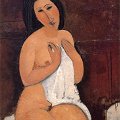 Amedeo Modigliani, an Italian painter, known for his
portraits and erotic nudes, deliberate distortion of the
figure and free use of large, flat areas of color. Despite their extreme
economy of composition and neutral backgrounds, Modigliani's portraits
convey a sharp sense of the sitter's personality, featuring a simple but
monumental use of line, and arresting arrangement of curved lines and
planes as well as a striking idealization of feminine sexuality. His art
was very individual and unique, especially later in his career. His
incisive portraits, erotically charged nudes, elegant drawings of
caryatids, and primitivistic sculpture have been admired for decades.
Modigliani's portraits and single-figure paintings are among the most
memorable and popular images of the early twentieth century. They possess
an archetypal quality that sets them apart from the art of his
contemporaries in Paris. Like the artist's nudes, they testify to an
enduring fascination with the human form and physiognomy.
Amedeo Modigliani, an Italian painter, known for his
portraits and erotic nudes, deliberate distortion of the
figure and free use of large, flat areas of color. Despite their extreme
economy of composition and neutral backgrounds, Modigliani's portraits
convey a sharp sense of the sitter's personality, featuring a simple but
monumental use of line, and arresting arrangement of curved lines and
planes as well as a striking idealization of feminine sexuality. His art
was very individual and unique, especially later in his career. His
incisive portraits, erotically charged nudes, elegant drawings of
caryatids, and primitivistic sculpture have been admired for decades.
Modigliani's portraits and single-figure paintings are among the most
memorable and popular images of the early twentieth century. They possess
an archetypal quality that sets them apart from the art of his
contemporaries in Paris. Like the artist's nudes, they testify to an
enduring fascination with the human form and physiognomy.
 Nude on a Blue Cushion (1917)
© Amedeo Modigliani
Nude on a Blue Cushion (1917)
© Amedeo Modigliani
 Reclining Nude with Loose Hair (1917)
© Amedeo Modigliani
Reclining Nude with Loose Hair (1917)
© Amedeo Modigliani
 Seated Nude in Shift (1917)
© Amedeo Modigliani
Seated Nude in Shift (1917)
© Amedeo Modigliani
- Amedeo Modigliani Art, $29
 (135 pictures)
(135 pictures)
- Amedeo Modigliani. Portraits and figure paintings.
- Amedeo Modigliani. Erotica art nudes.
Paul Klee
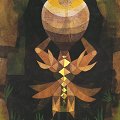 Paul Klee, Swiss German painter, one of the most
original masters of modern art. Klee created images known for their
fantastic dream-like qualities, wit, and imagination. He was
influenced by many different art styles, including
Expressionism, Cubism, and Surrealism. Klee was
also a master draftsman, and many of his works are elaborated line
drawings with subject matter that grew out of fantasy or dream
imagery. Throughout his career, Paul Klee used color in a variety of
unique and diverse means, in a relationship that has progressed and
evolved in a variety of ways. Klee was highly spiritual. Klee
tended to see the world as a model, a kind of illusion run up by the
cosmic clockmaker - God. This helps account for the toy-like character
of his fantasies; if the world had no final reality, it could be
represented in the freest, most schematic way. Klee's career was a
search for the symbols and metaphors. Many of his paintings are
a form of writing: they pullulate with signs, arrows, floating
letters, misplaced directions, and commas; their code for any object
makes no attempt at sensuous description, but instead declares itself
to be a purely mental image, a hieroglyph existing in
emblematic space. Now Klee has become a classic whose pictures are
reproduced in their thousands. They have established themselves firmly
in the collective memory of mankind.
Paul Klee, Swiss German painter, one of the most
original masters of modern art. Klee created images known for their
fantastic dream-like qualities, wit, and imagination. He was
influenced by many different art styles, including
Expressionism, Cubism, and Surrealism. Klee was
also a master draftsman, and many of his works are elaborated line
drawings with subject matter that grew out of fantasy or dream
imagery. Throughout his career, Paul Klee used color in a variety of
unique and diverse means, in a relationship that has progressed and
evolved in a variety of ways. Klee was highly spiritual. Klee
tended to see the world as a model, a kind of illusion run up by the
cosmic clockmaker - God. This helps account for the toy-like character
of his fantasies; if the world had no final reality, it could be
represented in the freest, most schematic way. Klee's career was a
search for the symbols and metaphors. Many of his paintings are
a form of writing: they pullulate with signs, arrows, floating
letters, misplaced directions, and commas; their code for any object
makes no attempt at sensuous description, but instead declares itself
to be a purely mental image, a hieroglyph existing in
emblematic space. Now Klee has become a classic whose pictures are
reproduced in their thousands. They have established themselves firmly
in the collective memory of mankind.
 Woodland Berry (1921)
© Paul Klee
Woodland Berry (1921)
© Paul Klee
 Puppet Theatre (1923)
© Paul Klee
Puppet Theatre (1923)
© Paul Klee
 The Goldfish (1925)
© Paul Klee
The Goldfish (1925)
© Paul Klee
- Paul Klee Art, $25
 (150 pictures)
(150 pictures)
- Paul Klee. Life and work.
- Paul Klee. The freedom of creativity and artistic expression.
Joan Miro
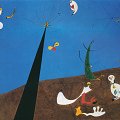 Joan Miro, a Spanish Catalan painter, internationally
acclaimed for his painting art which has been interpreted as
Surrealism, a sandbox for the subconscious mind, with strong traits
of innocence, minimalism, and the child-like character. Miro was at
the beginning of the Surrealist movement, but later he chose not to be
labeled as a Surrealist in order to be free to experiment with other
artistic movements and styles. He developed his own unique style: organic
forms and flattened picture planes drawn with sharp lines. He tried to
express himself through new materials: bark, textile, fiber, assemblages of
objects, collages, and so on. Miro has been a significant influence on late
20th-century art, in particular the American abstract expressionist
artists, such as Pollock and Rothko, with his lyrical abstractions and
color field paintings. "My characters have undergone the same process of
simplification as the colors. Now that they have been simplified, they
appear more human and more alive than if they had been represented in all
their details." - Joan Miro.
Joan Miro, a Spanish Catalan painter, internationally
acclaimed for his painting art which has been interpreted as
Surrealism, a sandbox for the subconscious mind, with strong traits
of innocence, minimalism, and the child-like character. Miro was at
the beginning of the Surrealist movement, but later he chose not to be
labeled as a Surrealist in order to be free to experiment with other
artistic movements and styles. He developed his own unique style: organic
forms and flattened picture planes drawn with sharp lines. He tried to
express himself through new materials: bark, textile, fiber, assemblages of
objects, collages, and so on. Miro has been a significant influence on late
20th-century art, in particular the American abstract expressionist
artists, such as Pollock and Rothko, with his lyrical abstractions and
color field paintings. "My characters have undergone the same process of
simplification as the colors. Now that they have been simplified, they
appear more human and more alive than if they had been represented in all
their details." - Joan Miro.
 Person Throwing a Stone at a Bird (1926)
© Joan Miro
Person Throwing a Stone at a Bird (1926)
© Joan Miro
 Landscape by the Sea (1926)
© Joan Miro
Landscape by the Sea (1926)
© Joan Miro
 Dialogue of the Insects (1925)
© Joan Miro
Dialogue of the Insects (1925)
© Joan Miro
 Landscape (1925)
© Joan Miro
Landscape (1925)
© Joan Miro
- Joan Miro Art, $35
 (150 pictures)
(150 pictures)
Henri Matisse
 Henri Matisse, French artist, known for his use
of color to convey emotional expression, and his fluid, direct
and original painting style. As a printmaker, but principally as a
painter, Matisse is one of the best-known artists of the 20th century.
His mastery of the expressive language of color and drawing won him
recognition as a leading figure in modern art. Early in his career, he
was the leader of the Fauvist movement, a painting style which
focused on pure colors used in an aggressive and direct manner. Matisse
believed the arrangement of colors was as important as a painting's
subject matter to communicate meaning. He avoided detail, instead
using bright color and strong lines to create a sense of movement.
Although intellectually sophisticated, Matisse always emphasized the
importance of instinct and intuition in the production
of a work of art. He argued that an artist did not have complete
control over color and form; instead, colors, shapes, and lines would
come to dictate to the sensitive artist how they might be employed in
relation to one another. He often emphasized his joy in abandoning
himself to the play of the forces of color and design, and he
explained the rhythmic, but distorted, forms of many of his figures in
terms of the working out of a total artistic harmony.
Henri Matisse, French artist, known for his use
of color to convey emotional expression, and his fluid, direct
and original painting style. As a printmaker, but principally as a
painter, Matisse is one of the best-known artists of the 20th century.
His mastery of the expressive language of color and drawing won him
recognition as a leading figure in modern art. Early in his career, he
was the leader of the Fauvist movement, a painting style which
focused on pure colors used in an aggressive and direct manner. Matisse
believed the arrangement of colors was as important as a painting's
subject matter to communicate meaning. He avoided detail, instead
using bright color and strong lines to create a sense of movement.
Although intellectually sophisticated, Matisse always emphasized the
importance of instinct and intuition in the production
of a work of art. He argued that an artist did not have complete
control over color and form; instead, colors, shapes, and lines would
come to dictate to the sensitive artist how they might be employed in
relation to one another. He often emphasized his joy in abandoning
himself to the play of the forces of color and design, and he
explained the rhythmic, but distorted, forms of many of his figures in
terms of the working out of a total artistic harmony.
 Standing Nude (1947)
© Henri Matisse
Standing Nude (1947)
© Henri Matisse
 Interior with Goldfish Bowl (1914)
© Henri Matisse
Interior with Goldfish Bowl (1914)
© Henri Matisse
 Music (1939)
© Henri Matisse
Music (1939)
© Henri Matisse
 First Orange Still Life (1899)
© Henri Matisse
First Orange Still Life (1899)
© Henri Matisse
- Henri Matisse Art, $29
 (180 pictures)
(180 pictures)
- Henri Matisse. Life and work.
- Henri Matisse. The Music. The Dance.
- Henri Matisse. Simply painting and color.
- Henri Matisse. Paper cutouts.
Pablo Picasso
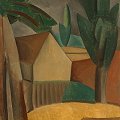 Pablo Picasso was probably the most famous artist
of the 20th century. During his artistic career, which lasted more
than 75 years, he created thousands of works, not only paintings but
also sculptures, prints, and ceramics, using all kinds of materials.
He almost single-handedly created Modernism. He
changed art more profoundly than any other artist of the century. Both
the quality and quantity of Pablo Picasso's art is unrivalled. His
paintings show the combination of natural and acquired ability that
earned him the title of an art genius and the most important artist of
the last century. Picasso launched Cubism and the revolution in
artistic expression which continues until the present. Prolific,
inventive, imaginative, and rebellious, only Da Vinci and Michelangelo are
currently more popular than Picasso. Not even Van Gogh or Dali command as
much popular interest or study.
Pablo Picasso was probably the most famous artist
of the 20th century. During his artistic career, which lasted more
than 75 years, he created thousands of works, not only paintings but
also sculptures, prints, and ceramics, using all kinds of materials.
He almost single-handedly created Modernism. He
changed art more profoundly than any other artist of the century. Both
the quality and quantity of Pablo Picasso's art is unrivalled. His
paintings show the combination of natural and acquired ability that
earned him the title of an art genius and the most important artist of
the last century. Picasso launched Cubism and the revolution in
artistic expression which continues until the present. Prolific,
inventive, imaginative, and rebellious, only Da Vinci and Michelangelo are
currently more popular than Picasso. Not even Van Gogh or Dali command as
much popular interest or study.
 Fruit Dish (1909)
© Pablo Picasso
Fruit Dish (1909)
© Pablo Picasso
 Landscape (1908)
© Pablo Picasso
Landscape (1908)
© Pablo Picasso
 Woman in an Armchair (1913)
© Pablo Picasso
Woman in an Armchair (1913)
© Pablo Picasso
 The Bathers (1918)
© Pablo Picasso
The Bathers (1918)
© Pablo Picasso
- Pablo Picasso Art, $29
 (175 pictures)
(175 pictures)
- Pablo Picasso. Art, life, and world of modern.
Salvador Dali
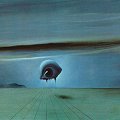 Salvador Dali, one of the greatest Spanish
painters of all time, and one of the most important figures in the
history of Modernism. Both Dali's extraordinary
talent and odd personality helped him to rise above the rest of the
Surrealists of the 20th century. His artwork and influences can be
seen almost everywhere around the world. His explicit and
controversial Surrealist paintings are some of the most famous, and
infamous, paintings of the 1900's, and his rebellious and independent
attitude towards art and politics set him aside from other painters,
leaving a mark on Surrealist painting forever. Dali expressed
surrealism in everything he said and did. He was not just
unconventional and dramatic; he was fantastic, shocking, and
outrageous. Salvador Dali remains one of the great artistic innovators
of all time. Like Picasso,
Matisse, Miro and
Chagall, his place at the pinnacle of modern
art history is assured.
Salvador Dali, one of the greatest Spanish
painters of all time, and one of the most important figures in the
history of Modernism. Both Dali's extraordinary
talent and odd personality helped him to rise above the rest of the
Surrealists of the 20th century. His artwork and influences can be
seen almost everywhere around the world. His explicit and
controversial Surrealist paintings are some of the most famous, and
infamous, paintings of the 1900's, and his rebellious and independent
attitude towards art and politics set him aside from other painters,
leaving a mark on Surrealist painting forever. Dali expressed
surrealism in everything he said and did. He was not just
unconventional and dramatic; he was fantastic, shocking, and
outrageous. Salvador Dali remains one of the great artistic innovators
of all time. Like Picasso,
Matisse, Miro and
Chagall, his place at the pinnacle of modern
art history is assured.
 Woman with a Head of Roses (1935)
© Salvador Dali
Woman with a Head of Roses (1935)
© Salvador Dali
 The Scenery for Labyrinth (1941)
© Salvador Dali
The Scenery for Labyrinth (1941)
© Salvador Dali
 The Elephants (1948)
© Salvador Dali
The Elephants (1948)
© Salvador Dali
 The Burning Giraffe (1937)
© Salvador Dali
The Burning Giraffe (1937)
© Salvador Dali
- Salvador Dali Art, $35
 (275 pictures)
(275 pictures)
- Salvador Dali. Art, life, and world of surreal.
- Salvador Dali. Early years. Art, paintings, and works.
- Salvador Dali. Surreal years. Art, paintings, and works.
- Salvador Dali. Classical years. Art, paintings, and works.
Marc Chagall
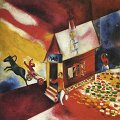 Marc Chagall, Russian-born French painter and
designer, distinguished for his surrealistic inventiveness. He is
recognized as one of the most significant painters and graphic artists
of the 20th century. His work treats subjects in a vein of humor and
fantasy that draws deeply on the resources of the unconscious.
Chagall composed his images based on emotional and poetic
associations, rather than on rules of pictorial logic. Predating
Surrealism, his early works were among the first expressions of
psychic reality in modern art. Chagall's personal and unique
imagery is often suffused with exquisite poetic inspiration.
Chagall's distinctive use of color and form is derived partly from
Russian Expressionism and influenced by French Cubism.
Marc Chagall, Russian-born French painter and
designer, distinguished for his surrealistic inventiveness. He is
recognized as one of the most significant painters and graphic artists
of the 20th century. His work treats subjects in a vein of humor and
fantasy that draws deeply on the resources of the unconscious.
Chagall composed his images based on emotional and poetic
associations, rather than on rules of pictorial logic. Predating
Surrealism, his early works were among the first expressions of
psychic reality in modern art. Chagall's personal and unique
imagery is often suffused with exquisite poetic inspiration.
Chagall's distinctive use of color and form is derived partly from
Russian Expressionism and influenced by French Cubism.
 Blue Lovers (1914)
© Marc Chagall
Blue Lovers (1914)
© Marc Chagall
 Self-Portrait with Palette (1917)
© Marc Chagall
Self-Portrait with Palette (1917)
© Marc Chagall
- Marc Chagall Art, $35
 (175 pictures)
(175 pictures)
- Marc Chagall. Art, life, and symbolic expression.
- Marc Chagall. Biography.
- Marc Chagall. About my art.
More
Movements
 Art Encyclopedia A world history of art in articles.
Art Encyclopedia A world history of art in articles.
Renaissance
Baroque
Romanticism
Impressionism
Postimpressionism
Modernism
Postmodernism
Art
 Art Wallpapers Art image collections for your desktop.
Art Wallpapers Art image collections for your desktop.
